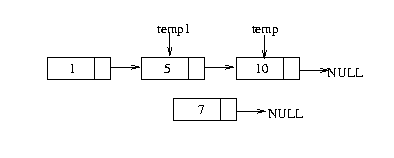Adding elements in the middle of a list
Well, if you managed till here I must really applaud your
patience. This section might be a bit tough, but I will try and
keep it as simple as I can.
As usual we start off by looking at some code. This time the
program actually does some useful work it is an insertion sort
program. The algorithm for insertion sort is really very simple.
Our program receives numbers one after another. We compare this
number with the numbers we have in a list and insert it in an
appropriate position. Though I must say this is not a very good
sorting algorithm, performance wise. The code can be downloaded
here.
0 #include<stdio.h>
1 //this macro calculates the size of
the array for us
2 //for eg if you pass it 10 element
array. In Linux
3 //sizeof(array) will be 40 bytes
since 1 int in Linux is 4 bytes
4 //Therefore size of array will be
40/4 =10 elements
5 #define NELEM(array)
(sizeof(array)/sizeof(int))
6 struct node{
7 int
n;
8 struct node
*next;
9 };
10 typedef struct node node;
11
12 node *Insert(node *first,int
number){
13 node
*new_node=(node *)malloc(sizeof(node));
14 node
*temp=first;
15 node
*temp1=first;
16
17
new_node->n=number;
18
new_node->next=NULL;
19
20
if(first==NULL){
21
first=new_node;
22
return first;
23 }
24
25
for(;temp!=NULL;temp=temp->next){
26
if(temp->n>number){
27
for(;temp1->next!=temp;temp1=temp1->next);
28
break;
29
}
30 }
31
32
if(temp==first){
33
new_node->next=first;
34
first=new_node;
35
return first;
36 }
37
38
if(temp==NULL){
39
for(;temp1->next!=temp;temp1=temp1->next);
40
temp1->next=new_node;
41
return first;
42 }
43
44 //insert
element in the middle
45
new_node->next=temp;
46
temp1->next=new_node;
47 return
first;
48 }
49
50 //the insertion sort function takes
the first node pointer and
51 //also the list of numbers to be
sorted
52 node *InsertionSort(node *first,int
list[],int n){
53 int
i=0;
54
55
for(i=0;i<n;i++){
56
first=Insert(first,list[i]);
57 }
58 return
first;
59 }
60
61 void printList(node *first){
62 node
*temp=first;
63
printf("List Contents:\n");
64
while(temp!=NULL){
65
printf("%d\n",temp->n);
66
temp=temp->next;
67 }
68 }
69
70 int main(){
71 node
*first=NULL;
72 int
a[]={1,453,345,356,3,65,6,4645,4};
73
first=InsertionSort(first,a,NELEM(a));
74
printList(first);
75 }
Phew! That was some bit of code. But never fear when Reuben is
near. We will take that apart part by part. If you do notice this
program has made use of both the concept's I've explained till now.
That is inserting elements in the beginning and inserting elements
at the end.
The main function
76 int main(){
77 node
*first=NULL;
78 int
a[]={1,453,345,356,3,65,6,4645,4};
79
first=InsertionSort(first,a,NELEM(a));
80
printList(first);
81 }
This is simple all we do here is create a pointer to hold the
list, then create an array to be sorted. Line 3 calls the sort
function, and ofcourse you should know what Line 4 does by now.
The InsertionSort function
The work of this function is simple it just goes through the
array calling the insert function which inserts the element in the
right position.
The Insert function
82 node
*new_node=(node *)malloc(sizeof(node));
83 node *temp=first;
84 node *temp1=first;
85
86 new_node->n=number;
87
new_node->next=NULL;
Now we have the juicy part. This is the function where all the
action happens. Let us start off by looking at the variables used.
At line 0 as usual we create a new node for the list and in line 4
and 5 the assignment of the same happens. In line 1 we have the
temp variable which is used to traverse the list. In line 2 we have
the temp1 variable that is used to traverse the list once we have
traversed the list. I'll explain that statement in a while.
88
if(first==NULL){
89
first=new_node;
90 return
first;
91 }
92
The section of code above checks to see weather the element
inserted is the first one or not. If it is the first one then the
first pointer is made to point to it and the first pointer is
returned.
93
for(;temp!=NULL;temp=temp->next){
94
if(temp->n>number){
95
for(;temp1->next!=temp;temp1=temp1->next);
96
break;
97 }
98 }
If we escape the above "if" construct unscathed we land in to
this weird looking for loop. This is a more compact way of
traversing the list. Since we already assigned temp to first in the
begining of the function we don't need to do it again. The
condition for the loop is that temp must not become NULL, and next
part of the loop is the actual traversal.
In the above code segment's if construct we check whether the
number stored in the node greater than the number entered. If that
is the case the we use the temp1 variable to traverse the list and
stop in the node before temp. Thats what I meant when I said temp1
is used traverse the list once we have traversed the list.
Pictorially it can be shown as follows.

99
if(temp==first){
100
new_node->next=first;
101
first=new_node;
102 return
first;
103 }
104
This section of code gets control when the while loop breaks. If
it happens that the temp points to the first node. The new node is
inserted at the begining of this list.
105
if(temp==NULL){
106
for(;temp1->next!=temp;temp1=temp1->next);
107
temp1->next=new_node;
108 return
first;
109 }
The code above should be obvious. If temp is pointing to NULL
that means that we are at the end of the list. Therefore, we insert
the new node at the end of the list.
110
new_node->next=temp;
111 temp1->next=new_node;
112 return first;
This is the intresting part. Here we insert the node in the
middle of the list. We make new_node point to temp. Once this is
done we make temp1's next pointer point to new_node. This is shown
in the diagrams below.


I think that all there is to the program once you have mastered
this section and the previous section you should be able to write
simple programs that make use of link lists. In the next few
sections I will be concentrating on removing elements from a link
list.


